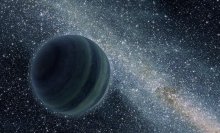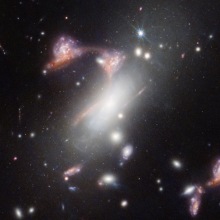Around the turn of the 21st century, a new age of galactic discovery began.
Through the latest telescopes on land and in space, astronomers started spotting a wealth of planets outside our solar system, called exoplanets. In our Milky Way galaxy, scientists have confirmed over 4,480 exoplanets, with thousands of more candidates. Some are likely rocky worlds. Many are part of a class of planets dubbed "super-Earths," orbs twice to ten times as massive as our balmy blue world. Others are gas giants like the imposing Jupiter.
There could be well over a trillion exoplanets in our galaxy alone. But we know vanishingly little about them.
"We've only been able to barely scratch the surface," explained Néstor Espinoza, an exoplanet researcher at the Space Telescope Science Institute, which runs the recently launched James Webb Space Telescope, or JWST.
"We've only been able to barely scratch the surface."
The eagerly anticipated telescope will capture unprecedented images of some of the deepest realms of space, where the earliest galaxies formed. But the powerful space instrument will also devote considerable time — a full quarter of its first year and likely more time after that — to peering at exoplanets here in the Milky Way.
JWST carries specialized equipment, called spectrometers, that will revolutionize our understanding of these far-off worlds. We'll discover if the atmospheres' of these planets, trillions of miles away, contain the stuff that allows life (as we know it) to flourish: essential ingredients like water, carbon dioxide, and methane. The instruments aren't expected to deliver any amazing exoplanet photos, but they'll beam back a wealth of information about worlds we can still only imagine.

Seeing the unseeable
Some of the most common exoplanets are super-Earths. The exoplanet Kepler-186f, for example, is a little larger than Earth and orbits its star in a region where liquid water can exist (called the habitable zone). But planetary scientists consider other super-Earths to be merciless places, like K2-131b, which orbits so close to its star that it can "vaporize metal." Astronomers have found over 1,500 of these diverse super-Earths, so far. But they remain mysterious.
Are any of them remotely like Earth? We don't even know if they have atmospheres.
"Webb will enable us to make these detections," explained Espinoza. We'll see if any of these planets contain carbon dioxide and water like Earth's. "It's huge," he said.
Webb will peer at known exoplanets, as opposed to using precious telescope time sleuthing out new ones. Most were discovered by the profoundly productive, planet-hunting telescope Kepler, which stared intently at stars in small windows of space for nearly a decade, looking for dips in their brightness. Those dips were often caused by planets passing in front of their stars. Even for the mighty JWST — with a gold-tinted mirror over 21 feet wide — these distant super-Earths will appear as dots. But the telescope can still learn a huge amount about these worlds' atmospheres.
Astronomers will employ a clever tactic to see the unseeable. They'll wait for planets to travel in front of their bright stars. This starlight passes through the exoplanet's atmosphere, then through space, and ultimately into instruments called spectrographs aboard JWST (a strategy called "transit spectroscopy"). They're essentially hi-tech prisms, which separate the light into a rainbow of colors. Here's the big trick: Certain molecules, like water, in the atmosphere absorb specific types, or colors, of light. "Each molecule has a specific diet," explained Espinoza. So if that color doesn't show up in the spectrum of colors observed by a Webb spectrograph, that means it got absorbed by (or "consumed" by) the exoplanet's atmosphere. In other words, that element is present in that planet's skies. The spectrograph produces lines (designating different types of light), not pretty pictures; but it's a wealth of invaluable information.


"We're going to be able to tell what [the planets] are made of," said Mercedes López-Morales, an exoplanet researcher and astrophysicist at Center for Astrophysics-Harvard & Smithsonian, a collaborative research group between the Smithsonian Astrophysical Observatory and the Harvard College Observatory. López-Morales is on a team researching exoplanet atmospheres with Webb's forthcoming observations. (The spectrometers will gather information about atmospheres in other ways, too, but transit spectroscopy is a primary method, she explained.)
For bigger planets orbiting far from their stars, like Neptune or larger, Webb will actually take direct images of these worlds. These sizable planets, often young and hot gaseous monsters, emanate much more light than smaller planets. This is infrared light, which the human eye can't see, but Webb can see it, and in large enough quantities to decipher it from trillions of miles away.

Is there life out there?
Webb will tell us if our solar system is strange, or normal. (Alternatively, it might just tell us whether or not there is a normal).
Questions abound. What are most solar systems like? Is a planet like Earth, a place teeming with water and orbiting in a relatively pleasant habitable zone, rare? Do our gas giants, like Jupiter and Saturn, have atmospheres similar to other such behemoths?
"Webb will, for the first time, allow us to put our solar system in context," said López-Morales.
But it won't tell us if a planet hosts life. A world may have all the right ingredients, but identifying life is well beyond the capabilities of even the most powerful space telescope ever built. "Does it have life or not? That's a very complicated question," emphasized Espinoza.
It's complicated because a slew of ingredients factor into habitability. A planet's atmosphere might end up being extremely thick and heavy, like Venus', which extinguishes the possibility of surface life. Or perhaps a world is flush with water, but it's dominated by intense ice ages, leaving few chances for organisms to flourish. This is all integral knowledge. "Claiming a planet is like Earth takes a lot of information," said López-Morales.
But, crucially, Webb's observations will point exoplanet scientists in the right direction. "It takes us to the next level," said López-Morales. A planet with elements and conditions somewhat similar to Earth would be scientific gold. Such a world would "immediately become a high priority candidate" for further investigation, she said.


Even more advanced future telescopes, potentially launched into space in the 2030s and designed to better probe Earth-like exoplanets, could then pursue Webb's promising leads.
Though, importantly, as humanity seeks the potential for life in exoplanets located in balmy regions of solar systems, we may inherently ignore other places where life could blossom. In our home solar system, scientists are excited about the prospects of lifeforms flourishing in (suspected) salty seas on Jupiter's distant moon Europa. Saturn's moon Enceladus, too, may host an ocean under a shell of ice. "These places where we think life could exist are all outside the habitable zone," noted Jason Steffen, an assistant professor of physics at the University of Nevada, Las Vegas, who researches exoplanets. Focusing on regions where a world like Earth might exist could give us blinders.
"We might learn things we never thought about."
Still, JWST will give humanity an unprecedented picture (though not literally) of what's out there, orbiting other stars in the galaxy. Who knows what we'll find.
"We might learn things we never thought about," said López-Morales.
Topics Innovations































